Thursday July 15
Today is departure day from Resolute to Devon Island. We have chartered with Kenn Borek Air to fly us via Beechy Island to our drop off place on Devon Island. As usual, everything is weather permitting and as usual weather delayed. The 9am departure rolls into noon when at 1pm, suddenly it’s a go. A final flurry of packing ensues, we wolf down some lunch, pay and depart. The fog and clouds have lifted enough for flights to resume (although it appears just as socked in to me now). Mickey wants us to phone him every few days as a check in but we settle at a weekly sat phone call just to say all is well.
It feels odd to be on such a large plane and such a little load. There are only Alfred and I, the two pilots (Rod from Alberta and Shawn from Yellowknife) and our gear (2 backpacks, 3 barrels with gear/fuel/grub and the gun). Take off is easy on a well maintained gravel strip, I get a good look at town below: the division between the airport warehouses and residence is obvious. So is the ice that lies frozen in three direction surrounding town – no wonder it is so continually exposed to bad weather.
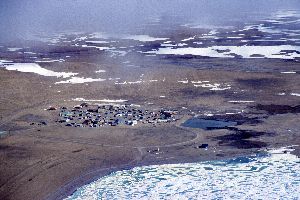
The first 30 minutes of flight are clear below. I watch out the window as the flatness and emptiness of Cornwallis and then Devon Island roll by. It’s also apparent that there is a significant amount of unmelted snow. I’m somewhat concerned, as the locals confirm summer is indeed at least 2 weeks behind schedule. I don’t want our hiking/backpacking to turn into a winter camping trip! We have no snow shoes or other winter gear…
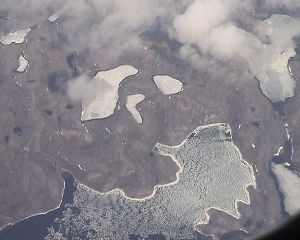
We wanted to stop at Beechy Island, the site of the Sir John Franklin expedition over wintering in 1846 but its too foggy. After one fly over and a 2nd aborted attempt, we have to continue on. I’m disappointed but know that transportation in the arctic is at the whim of the weather. Same aborted landing story happened when on Ellesmere and hoping to land at Fort Conger ( wintering site for Peary on his race to the north pole). However to have come that close, and be limited to a fly over is let down. I strain to see between the clouds and am rewarded by a glimpse of gray rock rubble beach – wholly desolate and uninviting.
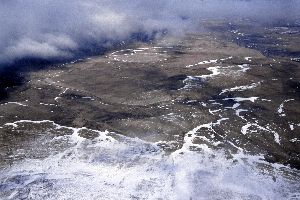
Our flight drones onward, the twin otter swings north across Devon, following up a deep rutted valley. More fresh snow fall is evident, frozen ponds and small water courses gray silver or white snow ditches in contrast to the naked coffee coloured rock plains. Finally the north shore comes in to view. What a contrast to the glimmer of sun and peeks of open blue water of the north west passage. Here, only the barest hint of summer has warmed the land. The sea is frozen tight to the shore (although pools of melt water dot the ice surface), ponds frozen and nothing moves below. A cluster of ancient quanset huts appears below, their faded roof tops blending into the tundra, huddled forlornly between two frozen ponds.
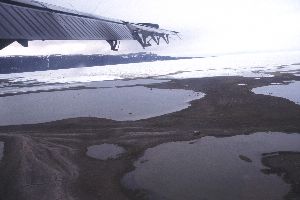
The plane descends, we bump along a short gravel strip, lined with dented fuel drums, make shift runway markers. It’s a precision deployment, long practiced and lubricated by experienced hands: within 3 minutes of landing, our gear is emptied, good byes said, the plane spins, takes off, disappears into the low lying clouds. Just as quickly, its mechanical drone fades into the distance, all sounds swallowed by the thirsty thick fog.
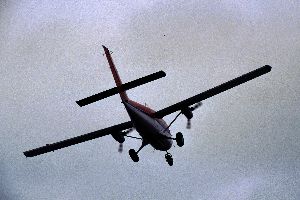
We are alone now. …a feeling of elation comes over me, finally, the summer is really about to begin! The first impression, constant in all arctic travel, is one of overwhelming quiet. After 9 months of being surrounded by the white noise, vibration and general hum of activity, the calm stillness and silence can almost hurt the ears. I inhale a deep breath of chilly air, swaddled in my down coat- yes, it’s July and I’m happy to have a cold dripping nose!
A light drizzle starts to fall, adding to the overall gloom. We quickly lug our heavy gear into the closest building, taking shelter inside its barrel vaulted plastic walls to assess what we will do next. The door is unlocked but carefully latched with a large 2’ x 4’ ( to discourage marauding polar bears? Or more likely) to discourage curious foxes from pushing the door open and using it as a den (or outhouse!). Inside, it is cold with a sagging wood floor that is well past its prime. Mold and mildewy rot smell mixed with overflow from the rustic oil heater, add to the camp atmosphere. We unshutter three small windows to let in what ever daylight there is but headlamps and candles are needed for detailed gear fumbling. Quickly water is scooped (unfiltered) from a partially unfrozen pond, and our traditional welcome espresso is brewed.
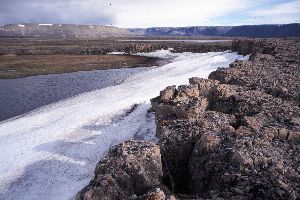
It’s exciting to land in a completely unknown new place. Everything is new, I want to run in different directions all at once. A brightening in the westward sky entices us to stroll northwards, along the flat low lands towards frozen Jones sound. It’s my favourite kind of journey with no end destination, no schedule and infinite time to look. Arctic loons and old squaw ducks are squawking noisily as we wander. Other birds, gulls, Lapland longspurs, snow buntings flit from rock to rock, calling out to each other. A few harmless mosquitoes flit around but don’t land nor bite. Gravel hummocks are linked by tire ruts from previous visitors. A small complete musk ox skull is nestled at the base of a ridge, exposed by retreating snow patch. It’s a fresh death, the orbital eye ligament is still attached. Patches of quiviat (musk ox under fur) have been rubbed on to rock ribs, convenient scratching posts. Jagged pyramidal ice bergs, pierce the frozen canvas of Jones Sound, how far from shore, its impossible to estimate - eye candy everywhere. Eventually, the sun sinking lower, we turn back to camp.
We weren’t keen on making this collection of buildings our base camp but the pilots didn’t want to land anywhere else with unknown and too soft landing conditions. Thus deposited, we take advantage of the situation and decide to remain in the area. Like always, we are ever aware for the presence of polar bears – but find no latent evidence of ripped siding, caved in doors/windows, gnaw marks 1.5 m above the ground, fresh seal kills – thus relax our guard. We observed seals basking beside long fractures in the seal ice and hope that bears have long learned that this inland camp offers little in the way of food opportunity, thus stick to the ice and no future surprises in store for us.
A family of foxes, at first shy, then more boldly, makes it presence known. They have excavated a den under the adjacent hut and loll near the entrance, escaping to the underground safety when we accidentally intrude on their personal space. The adult female romps past me, and stops to check out a small groove in the earth. Her tail cocked, muzzle buried out of my line of sight, I can see that she has found something of interest. After she exhausts the source of interest, I check to see what she has found. To my disgust, there is river of cold slimy oatmeal, obviously dumped by some not too long ago visitors. The congealed gray mass sits like a blemish between rocks and short emerging grasses stalk. Yuk! With closer inspection around the buildings, other recent food garbage is evident (carrot stubs, potato bits). Eventually we find a trip log in the kitchen hut with the names of the likely guilty party…
Sleeping pads are unrolled inside, down sleeping bags fluffed, windows shuttered against the light. It’s been a long but satisfying first day, I quickly fall asleep, dreaming of more to come.